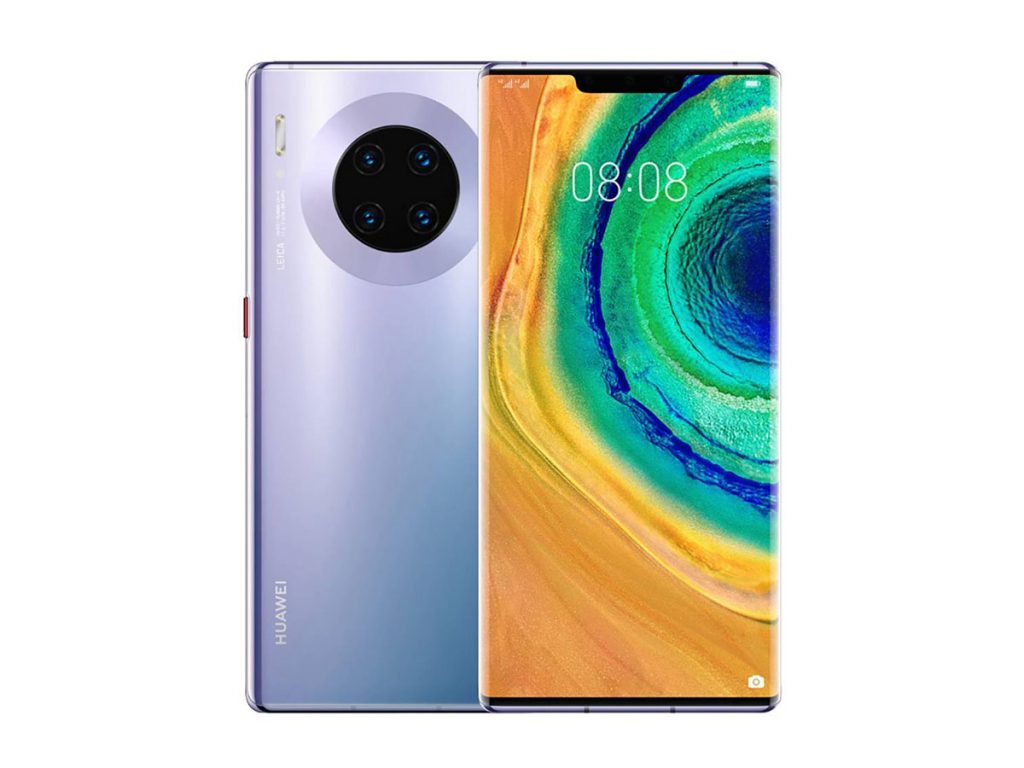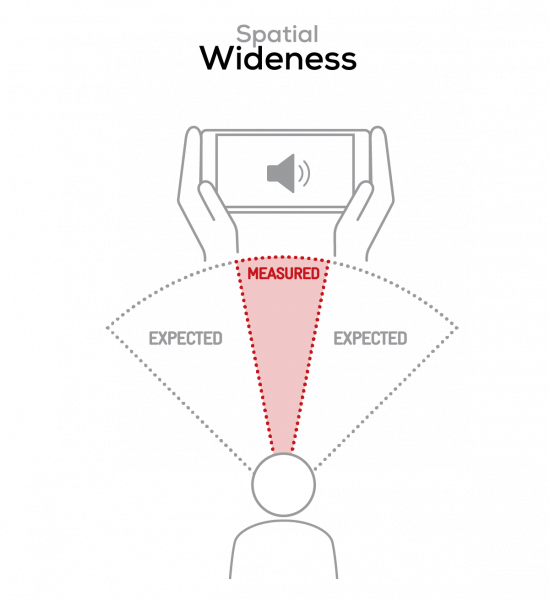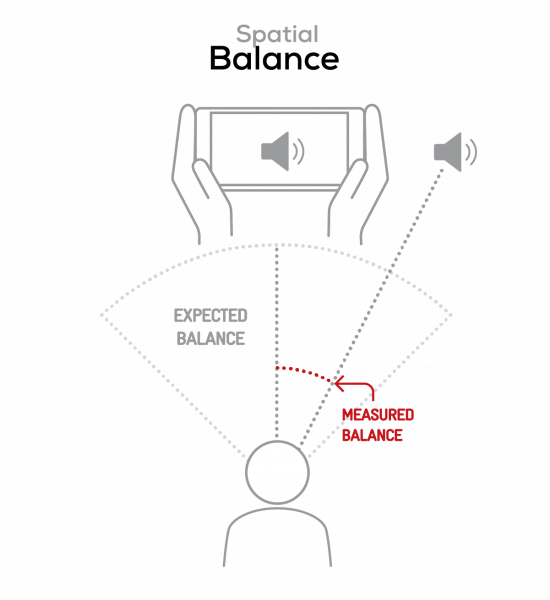The Huawei Mate 30 Pro 5G is the 5G-equipped, premium version of Huawei’s latest high-end device. Like its LTE sibling, it is equipped with a powerful Kirin 990 SoC, a 6.53-inch FHD+ OLED display, and a quad-camera setup. It comes with a generous 8GB of RAM and as much as 512GB of built-in storage, along with room for a nano-SD card. (Note, however, that even though the Mate 30 Pro ships with Huawei’s EMUI version of Android 10, it does not support Google’s primary applications.)
In this concise review, we’ll focus on the differences between the Huawei Mate 30 Pro 5G and the standard version. For more detailed results, you can also refer to our Huawei Mate 30 Pro Audio review.
Key audio specifications:
- Acoustic display (not used for media playback)
- Dedicated microphone for active noise cancellation
About DXOMARK Audio tests: For scoring and analysis in our smartphone audio reviews, DXOMARK engineers perform a variety of objective tests and undertake more than 20 hours of perceptual evaluation under controlled lab conditions. This article highlights the most important results of our testing. Note that we evaluate both Playback and Recording using only the device’s built-in hardware and default apps. (For more details about our Playback protocol, click here; for more details about our Recording protocol, click here.)
Test results


Overall, the 5G version of the Mate 30 Pro performed nearly identically in our audio tests to the LTE version we tested a short time ago. In fact, while there are some slightly audible differences, at 61, its final score is only a single point higher than that of the LTE version, driven by a one-point improvement in Playback Timbre and Artifacts.
The Mate 30 Pro 5G remains in the lower half of phones we’ve tested—not what you would expect for a flagship device. Playback is where it suffers the most, with a Playback sub-score of 58. Recording is much stronger, with the phone scoring 72, tied for the best score of any device we’ve tested so far. It takes the lead over the LTE version thanks to slightly improved accuracy in tonal range reproduction and fewer audio playback artifacts.
Playback
For playing media, the 5G model, like the LTE version, has only one single-channel speaker. It also has an acoustic display, but that isn’t used for media playback, so it doesn’t figure in any of our Audio test results or scores. Given that significant limitation, the Mate 30 Pro 5G does a pretty good job with playback performance, except at high volumes. Playback quality is held down by its low Playback Spatial sub-score of 30, as the single speaker provides almost no sound stage, although it has surprisingly good sound localization for a single-speaker device.
Tonal reproduction is fairly good, giving it a Playback Timbre sub-score of 62. Treble is precise, but brilliant and almost tinny sounding, with the mid-range sounding clean and natural except at the top three volume settings. The 5G version has slightly improved bass response when compared to the LTE version, which contributes to its higher Timbre sub-score, as you can see here in this comparison graph:
Media played back on the phone has fairly good sound dynamics overall, including very good attack when listening at low- and medium-volume settings. The improved bass also helps here. At high volumes, though, audio lacks punch and attack is no longer precise. Playback volume is also a mixed bag. While volume steps are reasonably linear, as you can see in the charts below, maximum volume is not very loud, and the minimum volume setting is almost inaudible.
Maximum playback volume isn’t great, although essentially identical to the levels we measured on the LTE version:
| Hip-Hop | Classical |
| 71.4 dBA | 68.7 dBA |
In terms of sound stage, the device’s scores suffer because of its mono speaker design. There is essentially a total lack of wideness, and balance is not accurate.
Sound reproduction is largely free of audible artifacts, with very well-controlled distortion levels except at maximum volume, leading to a Playback Artifacts sub-score of 84. Unfortunately, it is easy to accidentally place a finger over the single speaker, which seriously degrades audio quality. High volumes also suffer from degradation in tonal response and sound dynamics.
Recording
When recording, the Mate 30 Pro 5G does a very good job of preserving tonal range, giving it an excellent Recording Timbre sub-score of 82. Bass response is particularly good compared to other phones. Recordings also have excellent spatial and dynamic characteristics, further contributing to the phone’s top-rated Recording score of 72. One slight problem is that tonal balance can be too brilliant because of high-end resonances. Also, some audible distortion and volume pumping occur when recording loud sound sources.
Recording levels for all our use cases were also within acceptable levels:
| Meeting | Life Video | Selfie Video | Memo |
| -23.1 LUFS | -18.9 LUFS | -18 LUFS | -19.4 LUFS |
The phone does a reasonably good job of minimizing artifacts when recording, but bass suffers from distortion at high sound levels, and there is slight volume pumping. Unfortunately, the microphones are also easy to occlude. Overall, the Mate 30 Pro 5G achieved a mid-pack Recording Artifacts sub-score of 69. You can listen for yourself with this sample from our artifacts test samples:
Background sounds have good tonal balance, although there are some high- and low-frequency resonances that impact performance. Noise cancellation also results in some artifacts for background noises.
Conclusion: Weak playback, but good recording
The Huawei Mate 30 Pro 5G doesn’t provide a very compelling listening experience, especially for a flagship phone. In large part that is due to its mono-channel, single-speaker design. Some slight improvements in tonal response give it a small advantage over the LTE version we tested previously.
The phone is a much better performer when it comes to recording audio, doing an excellent job that places it along with its LTE sibling at the top of the phones we’ve tested.
Playback
Pros
- Good overall audio playback for a mono-speaker device
- Timbre and dynamics are quite good for most volume steps
- Decent distance and localization of sound sources, despite being a mono device
Cons
- Large decrease in audio quality at the top three volume steps
- A lack of wideness and very unbalanced recordings due to mono speaker
- Maximum and minimum volume are both too low
Recording
Pros
- Excellent tonal response, with clear treble and natural mid-range
- Very good audio file loudness and maximum acceptable recording level
- Spatial and dynamics performances match the best-in-class devices
Cons
- Tonal balance can be brilliant because of high-end resonances
- Noise cancellation can induce voice resonances in background sounds
- At high volume levels, bass distortion, bass resonances, and slight pumping effects occur






DXOMARK encourages its readers to share comments on the articles. To read or post comments, Disqus cookies are required. Change your Cookies Preferences and read more about our Comment Policy.